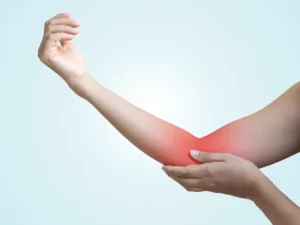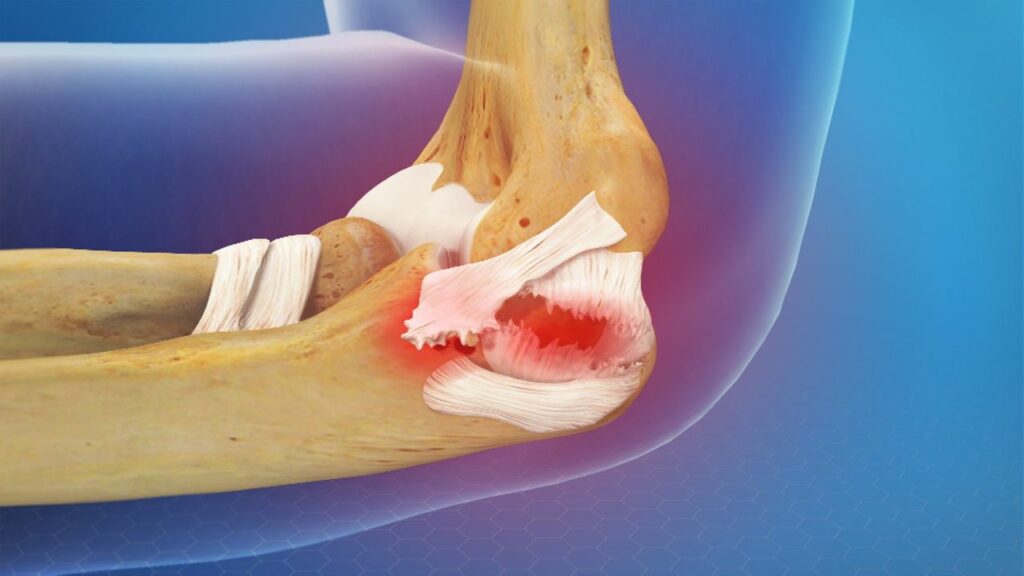Elbow ligament injuries are a common occurrence among athletes, fitness enthusiasts, and even individuals engaged in day-to-day activities. Whether it’s a sprain, tear, or overuse, an elbow ligament injury can be a painful and often debilitating condition that can affect one’s quality of life. Understanding the underlying causes, recognizing the symptoms, and being aware of available treatments and preventive measures is essential in managing this condition effectively. This blog post aims to shed light on elbow ligament injuries, providing an in-depth guide for anyone who wants to understand, prevent, or recover from this common ailment.
Contents
Can Ligaments Heal On Their Own?
 Ligaments are the fibrous connective tissues that connect bones to other bones. And they play a crucial role in stabilizing joints. When a ligament is injured, it can sometimes heal on its own, depending on the severity and type of injury. Mild ligament sprains, where the ligament is stretched but not completely torn, can often heal without surgical intervention.
Ligaments are the fibrous connective tissues that connect bones to other bones. And they play a crucial role in stabilizing joints. When a ligament is injured, it can sometimes heal on its own, depending on the severity and type of injury. Mild ligament sprains, where the ligament is stretched but not completely torn, can often heal without surgical intervention.
The body’s natural healing process will work to repair the damaged fibers, and the ligament can return to normal function. However, it’s important to note that this healing process can be slow. Because ligaments receive a limited blood supply. This is why they can delay recovery. More severe ligament injuries, such as complete tears, may not heal adequately on their own and may require medical intervention.
Ignoring or improperly treating a ligament injury can lead to chronic pain, instability, or even arthritis in the affected joint. Therefore, consulting a healthcare provider to determine the best course of action for an individual’s specific situation is always recommended.
What Are The Causes Of Elbow Ligament Injury?
Elbow ligament injury can be caused by a variety of factors that place stress or strain on the ligaments within the joint. Here’s a breakdown of some of the common causes:
- Repetitive Motion
Engaging in activities or sports that require repeated elbow movements can lead to overuse injuries. Sports like baseball, tennis, and golf often put stress on the elbow ligaments. Eventually, leading to conditions like Tennis Elbow or Golfer’s Elbow.
- Sudden Trauma
A direct blow to the elbow or a sudden twist, fall, or collision can cause ligament sprains or tears. This can happen during contact sports, accidents, or falls.
- Improper Technique
Whether lifting weights or swinging a racket, improper technique can put undue stress on the elbow. Ultimately, leading to ligament injuries.
- Occupational Risks
Certain jobs that require repetitive elbow movements or heavy lifting can contribute to wear and tear on the elbow ligaments.
- Underlying Health Conditions
Conditions such as rheumatoid arthritis can weaken ligaments and make them more susceptible to injury.
- Previous Injuries
If you’ve had a previous elbow injury, the ligaments may be weakened, making them more prone to future injuries.
- Lack of Flexibility or Strength
Weak or inflexible muscles surrounding the elbow can result in increased stress on the ligaments, predisposing them to injury.
- Age-Related Factors
As people age, ligaments might become more brittle and less flexible. This can make them more prone to injury.
- Genetic Factors
Some individuals might be more predisposed to ligament injuries due to their genetic makeup, although this is less common.
Understanding these causes is vital for both prevention and treatment. It’s often beneficial to work with healthcare or fitness professionals who can help you identify your specific risk factors and design an appropriate exercise or treatment program to minimize these risks.
What Are The Common Symptoms To Know?
 Elbow ligament injuries can present with a variety of symptoms. And being aware of these signs can help in identifying an issue early, allowing for prompt medical attention and treatment. Here are the common symptoms associated with elbow ligament injuries:
Elbow ligament injuries can present with a variety of symptoms. And being aware of these signs can help in identifying an issue early, allowing for prompt medical attention and treatment. Here are the common symptoms associated with elbow ligament injuries:
- Pain: One of the most noticeable signs of a ligament injury is pain in the elbow. Particularly during movement or when applying pressure to the area. The pain may be sharp during certain activities or a dull ache at rest.
- Swelling: Inflammation can occur around the injured ligament. Eventually, leading to swelling in the elbow region.
- Limited Range of Motion: Difficulty or discomfort while bending or straightening the elbow could indicate a ligament issue. Stiffness may also occur, limiting the normal movement of the joint.
- Weakness: An injured ligament may cause the elbow to feel weak. That is making it difficult to lift objects or perform usual daily tasks.
- Instability: Some individuals may experience a feeling of looseness or instability in the elbow joint. As the ligaments are responsible for maintaining joint stability.
- Bruising: Depending on the severity of the injury, there may be visible bruising around the affected area.
- Popping or Clicking Sounds: Sometimes, a tearing or popping sound may be heard at the time of injury, or a clicking sound may be noticed during movement.
- Numbness or Tingling: Though less common, some may experience numbness or tingling radiating into the forearm or hand. Especially if the injury affects nearby nerves.
It’s important to note that not all of these symptoms will be present in every case, and they can vary in intensity. While some minor ligament injuries might heal with rest and home care, professional medical evaluation is often advisable.
How Do You Treat Elbow Ligament Injury?
Treatment for elbow ligament injuries can vary depending on the type, severity, and cause of the injury. An individualized treatment plan may include a combination of the following strategies:
1. Rest and Immobilization
Allowing the affected elbow to rest helps to prevent further damage and promotes healing. A splint or brace may be recommended to immobilize the joint temporarily.
2. Ice Application
Applying ice to the affected area can reduce swelling and alleviate pain. Ice packs should be wrapped in a cloth to prevent frostbite and applied for 15-20 minutes at a time.
3. Pain Relief Medications
Over-the-counter pain relievers such as ibuprofen or acetaminophen may be recommended to manage pain and inflammation.
A licensed physical therapist can design a rehabilitation program to restore strength, flexibility, and function to the elbow. This may include targeted exercises, stretching, and other therapeutic techniques.
5. Occupational Therapy
In cases where the injury impacts daily activities or occupation, occupational therapy may be beneficial in assisting the return to normal function.
6. Steroid Injections
In some chronic or severe cases, a healthcare provider may recommend corticosteroid injections to reduce inflammation.
7. Surgical
If the ligament is significantly torn or if conservative treatments are unsuccessful, surgical repair or reconstruction may be required. Surgery is typically followed by a structured rehabilitation program to ensure a full recovery.
8. Alternative Therapies
Some individuals may find relief through alternative therapies like acupuncture or massage, although these should be considered in conjunction with mainstream medical care.
Prompt medical evaluation is vital to determine the most effective treatment plan for an individual’s specific situation. Following the prescribed treatment regimen closely will maximize the chances of a full and speedy recovery. Ignoring or under-treating an elbow ligament injury can lead to chronic issues or complications. So professional medical care should always be sought.
How Long Does It Take For A Torn Ligament in The Elbow To Heal?
 The healing time for a torn ligament in the elbow can vary widely depending on the severity of the tear, the specific ligament affected, the individual’s overall health, and the treatment approach taken.
The healing time for a torn ligament in the elbow can vary widely depending on the severity of the tear, the specific ligament affected, the individual’s overall health, and the treatment approach taken.
In cases of a mild or moderate tear where non-surgical treatments are effective, healing may take anywhere from a few weeks to a few months. More severe tears, especially those requiring surgical intervention, may necessitate a longer recovery period, often ranging from several months to a year. Following surgery, a structured rehabilitation program will typically be implemented. And adherence to this program is crucial for optimal recovery.
It is essential to work closely with healthcare providers, such as orthopedic specialists and physical therapists, to understand the expected recovery time for your specific situation. And to follow their guidance for the best possible outcome.
Conclusion
Elbow ligament injuries, ranging from mild sprains to severe tears, are common occurrences that can affect anyone from athletes to those engaged in everyday activities. Understanding the causes, recognizing the symptoms, and being knowledgeable about the available treatments is essential in managing these injuries effectively. Whether it’s through prevention strategies, conservative treatment, or surgical intervention, a comprehensive approach tailored to the individual’s specific situation is crucial for successful healing.
Seeking professional medical guidance and following prescribed treatment plans can not only alleviate pain and restore function but also prevent future complications. This will ensure that the elbow remains strong and healthy throughout life. If you’re experiencing Elbow pain, physical therapy for elbow pain at PhysioMantra can help: Book an online physical therapy session.



